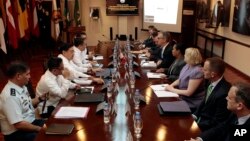MANILA —
Philippine negotiators are emphasizing the temporary nature of plans to have more American forces rotate through the Philippines as they work toward forging an agreement on the deployments with the United States.
The Philippine negotiators say there will be “clear language mandating” the presence of U.S. troops will be temporary.
They said at meetings with their U.S. counterparts in Washington, both sides agreed that any U.S. activities would first need Philippine approval. The Philippine side says places where equipment will be ready for U.S. forces to use will belong to the Philippines and anything built and funded by the U.S. for specific activities will be removed once the activities are over.
National Defense Spokesman Peter Paul Galvez says the guidelines of what the Americans will be allowed to do are all in keeping with the Philippine Constitution.
“As long as they are in the country, all the facilities would remain the property of the Philippines, because otherwise, it would be basing, right?”
The Philippines, a former American colony, was host to U.S. bases for nearly a century, but a surge of domestic opposition forced them to close in 1992.
For the United States, being welcomed in the Philippines will mean more access to a region where it is strengthening military, diplomatic and economic ties. The Philippines, which is modernizing its weak and aging military, sees more U.S. troop rotations as a way to strengthen its minimum credible defense posture in the face of growing territorial disputes.
A major issue is the South China Sea, where China says it has indisputable territory, while the Philippines, Vietnam, Malaysia, Brunei and Taiwan also have stakes in the resource-rich waters.
Philippine negotiator, Foreign Affairs Assistant Secretary Carlos Sorreta, said Friday after the meeting with the U.S. panel that the military buildup is not directed at any country. Instead he said, “the enemy is misunderstanding and uncertainty.” Sorreta says with this plan, “no nation should ever be uncertain that we will defend what is ours.”
The Philippines is looking to boost its maritime security and maritime surveillance capabilities through this partnership with the United States. Both sides plan training exercises and activities. And spokesman Galvez says the Philippines will have authority over these.
“Securing the perimeter and everything is of course under our responsibility of course, because it’s our country,” said Galvez.
In a statement, Sorreta said he expected the duration of the arrangement to be less than 20 years, which is the typical length of a U.S. program with other defense partners.
He says the negotiations are more than halfway through. The next meeting will be held in mid-September in Washington.
The Philippine negotiators say there will be “clear language mandating” the presence of U.S. troops will be temporary.
They said at meetings with their U.S. counterparts in Washington, both sides agreed that any U.S. activities would first need Philippine approval. The Philippine side says places where equipment will be ready for U.S. forces to use will belong to the Philippines and anything built and funded by the U.S. for specific activities will be removed once the activities are over.
National Defense Spokesman Peter Paul Galvez says the guidelines of what the Americans will be allowed to do are all in keeping with the Philippine Constitution.
“As long as they are in the country, all the facilities would remain the property of the Philippines, because otherwise, it would be basing, right?”
The Philippines, a former American colony, was host to U.S. bases for nearly a century, but a surge of domestic opposition forced them to close in 1992.
For the United States, being welcomed in the Philippines will mean more access to a region where it is strengthening military, diplomatic and economic ties. The Philippines, which is modernizing its weak and aging military, sees more U.S. troop rotations as a way to strengthen its minimum credible defense posture in the face of growing territorial disputes.
A major issue is the South China Sea, where China says it has indisputable territory, while the Philippines, Vietnam, Malaysia, Brunei and Taiwan also have stakes in the resource-rich waters.
Philippine negotiator, Foreign Affairs Assistant Secretary Carlos Sorreta, said Friday after the meeting with the U.S. panel that the military buildup is not directed at any country. Instead he said, “the enemy is misunderstanding and uncertainty.” Sorreta says with this plan, “no nation should ever be uncertain that we will defend what is ours.”
The Philippines is looking to boost its maritime security and maritime surveillance capabilities through this partnership with the United States. Both sides plan training exercises and activities. And spokesman Galvez says the Philippines will have authority over these.
“Securing the perimeter and everything is of course under our responsibility of course, because it’s our country,” said Galvez.
In a statement, Sorreta said he expected the duration of the arrangement to be less than 20 years, which is the typical length of a U.S. program with other defense partners.
He says the negotiations are more than halfway through. The next meeting will be held in mid-September in Washington.








